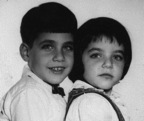How I Got Here

A premature twin (I'm still best friends with my delightful twin sister Dr. Nina Smiley, and proud to be the co-author with her of The Three Minute Meditator), I spent close to two months in an incubator in the days before the need for neo-natal contact was well known.
Whether that lack of connection affected me or not, I grew up to be a relatively unhappy and fearful young man, my mind always filled with fearful or angry or self-aggrandizing thoughts. I was smart (although not a good student) and sometimes funny, but it was not much fun being me. I was bullied, and a wanna-be macho guy who really wasn't very macho in a culture that was.
College
College was better (not so much bullying, once I reached my full size), but I was still vain and insecure.
After College
Following a near-death out-of-body experience (NDOOBE), then after a workshop I took with the seminal thanatologist (psychologist of dying and grieving clients) Dr. Elizabeth Kubler-Ross, I became interested in that field, and had the privilege of working with Dr. Charles Garfield (author of "Peak Performance") in the

A Lucky Break
After what seemed like a disastrous turn of fate to me (but ended up being a great boon in my life) I had the incredible good fortune to first experience a glimpse of the nature of my own mind at a ten day retreat led by the great American Buddhist Teachers Stephen Levine and Jack Kornfield, then to become a private student/Buddhist psychology client/spiritual friend ("kalyanamitta") of Jack Kornfield (visit him here) for almost two years. For a bit more detail on this, see "An Analytical Kind of Guy" in the Jnana Yoga section.
Since Jack was himself trained in the Vipassana Tradition of meditation, he emphasized beginning a meditation practice through focus on the process of breathing. And because I was a rather unpromising student, I spent a very long time with this. And eventually came to believe that even the simplest breathing meditations, diligently practiced over time, would produce powerful and transformative effects.
I also began to study, in person when I could, by book and tape when I couldn't, with the great Buddhist/thanatologists Stephen Levine and Ondrea Levine.
Growing Up a Little
Slowly, incrementally, and gradually, my mindfulness practice helped me to gain some degree of control over my thoughts and my mind, to settle down, to go to grad school (where my study of more than a hundred traditional and modern mental self-help strategies strengthened my belief in the power of breath meditation, and my thesis eventually became the basis of "The Three Minute Meditator." I was also able to get married and start a family.
I continued on and off work with terminally-ill and grieving folk, and those who work with them. And wrote some more books on mindfulness as well, such as:
MetaPhysical Fitness: The 30 Day Plan for Your Mental, Emotional, and Spiritual Health
Neural Path Therapy: How to Change Your Brain's Response to Anger, Fear, Pain, and Desire
Mindfulness To Go: How to Meditate While You're on the Move
With the encouragement of my mentors Stephen and Ondrea, in 1992 I began to teach mindfulness via harmonica, starting out with "spiritual" venues such as churches and the New York Open Center. By the mid-1990's I started being asked to do corporate type events. I began to teach at the lovely Kripalu Center for Yoga and Health in 2005, and began to develop HarmonicaYoga™.
And here we are.